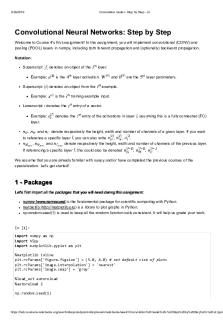Unrelated t-test SPSS step by step PDF

| Title | Unrelated t-test SPSS step by step |
|---|---|
| Course | Researching Psychological Worlds |
| Institution | University of East London |
| Pages | 7 |
| File Size | 617.1 KB |
| File Type | |
| Total Downloads | 94 |
| Total Views | 166 |
Summary
Unrelated t - test step my step for SPSS...
Description
Unrelated t-test: SPSS step by step
1. Open the data from Moodle Assessment: Study 4; “Study 4 Data SPSS”
2. Un-related t-test: Perceived Dangerousness Study To analyse the perceived dangerousness study data we are going to run an unrelated t-test, because this is a between participants design Two groups – social and biological cause We will produce a bar chart to show the differences between the means of the two groups Then we will carry out a t-test to see if this difference is significant.
3. Click on variable view
The first thing we need to do is provide values for both “Condition” and “Sex”
Click on the little blue box under values
Then for both Condition and Sex add the following values: o Condition: Social = 1; Biological = 2 o Sex: Female = 1, Male = 2
o You do this by putting the value into the value box (e.g. 1) the label into the Label box (e.g. Social) then click add, repeat the process for the other condition then click OK. o It’s the same process for Sex.
Now click on Data View By clicking on the A-1 tab on the top right hand of the toolbar you can check whether your labels have been added correctly
4. We’re now ready to create a Bar Chart
Click on Graphs, Legacy Dialogs, then Bar
Select Simple, Summaries of Groups of Cases and click Define
•
Click on ‘Other statistic (e.g. , mean)’; move Dangerousness into the ‘Variable’ box and ‘Condition’ into the ‘Category axis’ box. Click on OK
Your Bar Chart should look like this:
5. Running the unrelated t-test Click on Analyze, Compare Means, Independent Samples T Test
Move “Dangerousness” into the ‘test variable’ box and “Condition” into the grouping variable box.
Click on ‘Define Groups’. Enter ‘1’ for Group 1 and ‘2’ for Group 2, then Continue, then OK
6. Understanding the output The first table has the mean and standard deviation for the two conditions.
The second table gives you the t test results.
First, you have to check whether the variances are similar. This is the result of Levene’s test for Equality of Variances. If Levene’s is significant (below 0.05), this means the two conditions have different levels of variance. Here the Levene’s result is not significant.
This means we read the top line of the t-test results.
Results of the t-test.
This is the information we are interested in Find the… t- value: Degrees of freedom: p value (significance): Write out the results of the t-test following APA style guidelines (see lecture 15):...
Similar Free PDFs

STROWGER/STEP BY STEP SWITCH
- 1 Pages

Venue Analysis Step by Step
- 3 Pages

Sap mm configuration step by step
- 104 Pages

Convolution model Step by Step v2a
- 22 Pages

Learn Aspen Plus Step By Step
- 335 Pages
Popular Institutions
- Tinajero National High School - Annex
- Politeknik Caltex Riau
- Yokohama City University
- SGT University
- University of Al-Qadisiyah
- Divine Word College of Vigan
- Techniek College Rotterdam
- Universidade de Santiago
- Universiti Teknologi MARA Cawangan Johor Kampus Pasir Gudang
- Poltekkes Kemenkes Yogyakarta
- Baguio City National High School
- Colegio san marcos
- preparatoria uno
- Centro de Bachillerato Tecnológico Industrial y de Servicios No. 107
- Dalian Maritime University
- Quang Trung Secondary School
- Colegio Tecnológico en Informática
- Corporación Regional de Educación Superior
- Grupo CEDVA
- Dar Al Uloom University
- Centro de Estudios Preuniversitarios de la Universidad Nacional de Ingeniería
- 上智大学
- Aakash International School, Nuna Majara
- San Felipe Neri Catholic School
- Kang Chiao International School - New Taipei City
- Misamis Occidental National High School
- Institución Educativa Escuela Normal Juan Ladrilleros
- Kolehiyo ng Pantukan
- Batanes State College
- Instituto Continental
- Sekolah Menengah Kejuruan Kesehatan Kaltara (Tarakan)
- Colegio de La Inmaculada Concepcion - Cebu










